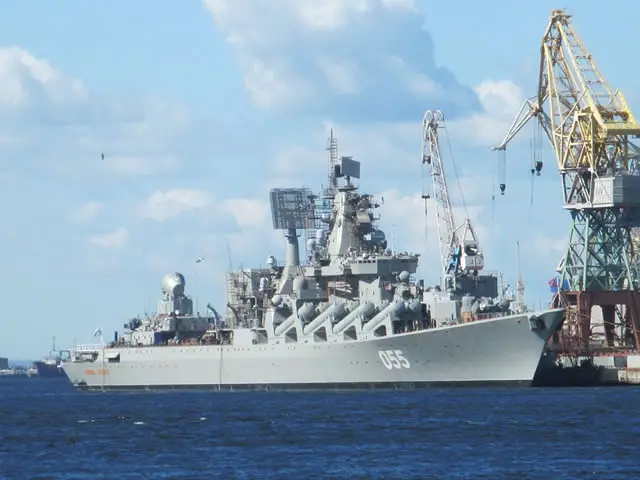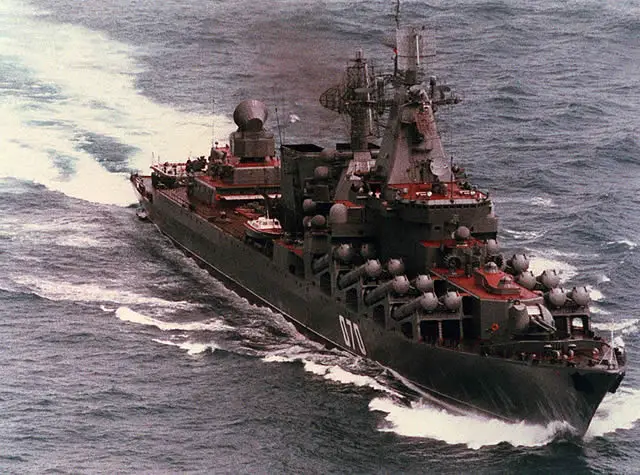Breaking news
Russian Navy Slava-class Cruiser Marshal Ustinov may be transferred to Black Sea Fleet.
| 2016
 Recent picture of Marshal Ustinov in final stages of refit and modernization at the Zvyozdochka Shipyard in Severodvinsk in north Russia. |
|||
When
the Moskva in January 2015 had to return to its home station for a long
time because she badly needed maintenance, she was replaced by the sister
ship Varyag sent by the Pacific Fleet. The Varyag’s deployment resulted
in the country’s lacking a single serious strike surface ship in
the Pacific and Indian oceans. In April, the Varyag headed for her home station. Since then, not only the air defense of our air base in Syria has been weakened, but also the Mediterranean Squadron has hardly been able to boast its overall combat power. The third Project 1164 missile cruiser, the Marshal Ustinov, has been at the Zvyozdochka Shipyard in Severodvinsk since 2011. The Project 1144 (Kirov-class) Pyotr Veliky nuclear-powered missile cruiser was repaired by the 82nd Shipyard near Murmansk, putting out to sea last May for the first time in two years. Her sister ship, the Admiral Nakhimov, will have been upgraded in Severodvinsk until 2018 at the least. The Black Sea Fleet was to start receiving the advanced Project 11356 (Krivak V/Admiral Grigorovich-class) frigates now in construction in Kaliningrad as far back as 2014. Only the lead ship of the series, the Admiral Grigorovich, has been delivered to date. The second frigate, the Admiral Essen, is still gearing up for a cruise from the Baltic Sea to Sevastopol. By force of circumstances, the Admiral Grigorovich will certainly be sent to Syria as soon as possible, but she will be unable to be a one-for-one replacement for the cruisers. The Admiral Ustinov’s medium repair and upgrade were to be completed in 2011, because such large-scale work was out of question in 2010, with only ordinary maintenance by Zvyozdochka planned at the time. Then, Moscow decided to equip the ship with advanced weaponry and replace her electronics, wiring and almost all mechanisms. The Project 1164 cruisers were built by the shipyard in the Ukrainian city of Nikolayev, where their design documentation left in the wake of the Soviet Union’s collapse. As a result, Zvyozdochka’s repair of the Marshal Ustinov slipped behind schedule so much that Vice-Premier Dmitry Rogozin, supervising military industry, had to fly to Severodvinsk urgently in late May. The problem is exacerbated by the Moskva’s being expected to occupy the berth to be vacated by the Marshal Ustinov. She will undergo the same repairs the sister ship is being subjected to now. This will take at least four years. Another problem crops up at once: how long can the Black Sea Fleet do without its flagship? The Defense Ministry’s idea to reassign the Marshal Ustinov to the Black Sea Fleet is due to its desire to resolve the problem. The ship will become the mainstay of the Mediterranean Squadron for several years. At the same time, it is becoming clear how the strike capabilities of the Mediterranean Squadron will be changing in a year or two. Most likely, the newly maintained Admiral Kuznetsov (Kuznetsov-class) aircraft carrier with an air wing of Sukhoi Su-33 (Flanker-D) fighters and Mikoyan MiG-29K/KUB (Fulcrum-D) multirole fighters onboard will head for Syria in October. Probably, the Admiral Kuznetsov will be escorted by the Severomorsk (Udaloy-class) antisubmarine warfare ship and the Pyotr Veliky nuclear-powered missile cruiser that has been urgently repaired and has spent her time at training and test ranges. Come spring, the upgraded Marshal Ustinov will replace them in the Mediterranean. Along with warships of other types, the guided missile cruiser will have added to the punch packed by our naval force in the Eastern Mediterranean until spring 2017 at the least, after which she will head for Sevastopol instead of the Arctic, expert Sergei Ischenko writes in his article on the Svobodnaya Pressa news website. © Copyright 2016 TASS. All rights reserved. This material may not be published, broadcast, rewritten or redistributed. |
|||



























